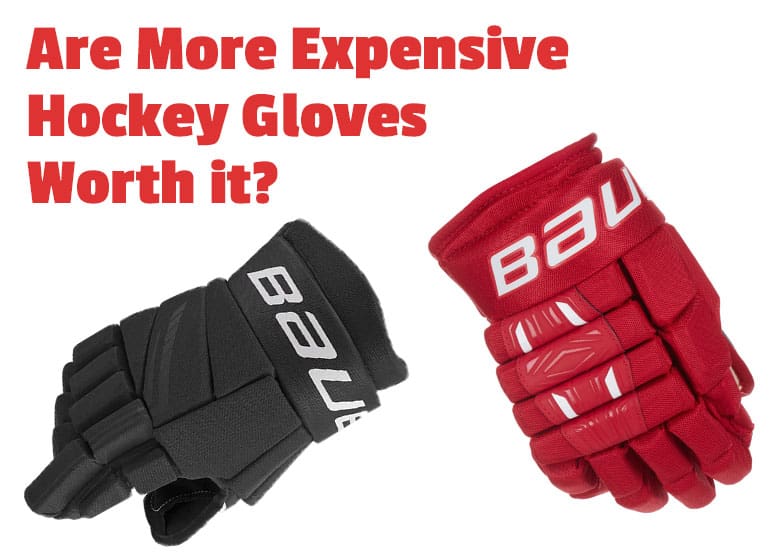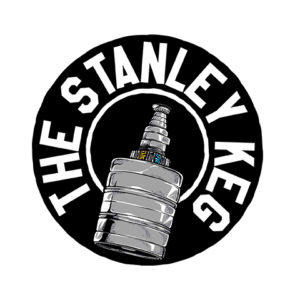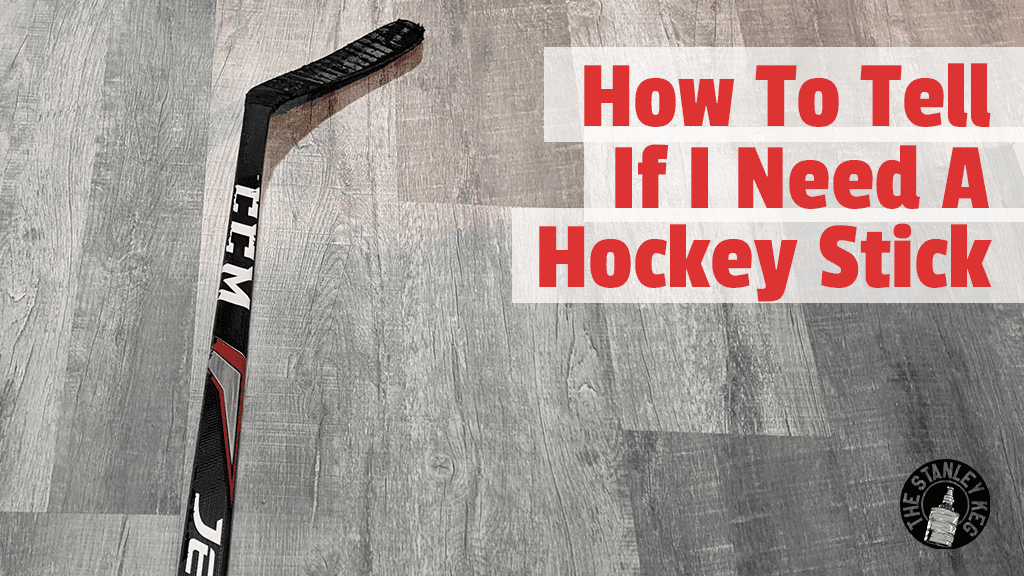
Are you wondering if you need a new hockey stick? We will help you figure out if it’s time to ditch your old twig and get a new piece of wood…or composite!
You know you need a new hockey stick if you feel like your stick has lost its pop. The more obvious reasons for replacing your stick are a broken blade or shaft. Other reasons for getting a new stick are selecting a more appropriate flex and choosing a blade curve more to your liking.
Read on and I will walk you through your decision on getting a new hockey stick as well as some other signs that your ice hockey stick needs to be replaced.
Can Ice Hockey Sticks Go Bad?
An ice hockey stick can definitely lose its fresh pop. As a stick ages you will notice that you can’t get a nice clean snappy shot off like you used to.
The compost and epoxy materials in both the shaft and the blade can start to break down with continued flexing. The materials actually start to soften up.
Your hockey stick will begin to lose its flex rating as it begins to age. If you bought a fresh stick with an 85 flex, you can expect it to lose a few pounds of that flex and begin to feel whippy.
When we say whippy we mean that the stick will flex easily but not shoot the puck off like a rocket but instead the puck can come off a bit waffley and not as hard as it should.
How Often Do You Need A New Hockey Stick?
The life of your hockey stick can vary drastically. I know that seems like a bad answer, but ask any player and they will tell you that they have had a stick last 3 games and then they have also had a stick last them 3 seasons.
The biggest factors in determining how long your stick will last you is how often you play and how aggressively you are using your stick. If you play at a higher level you should expect your stick to wear out quicker.
A common misconception is that a more expensive stick will last longer. This is not true. You are not paying the extra money for an extended lifespan. You are paying extra money for higher performance. In fact, more expensive sticks are often times more fragile than cheaper, heavier sticks.
How To Tell If My Hockey Stick Is Broken
The first thing you can do to tell if your stick is broken is to examine it visually. Are there any visible cracks on the blade or the flex point? To get a good look at the blade you should remove your stick tape.
Cracks on the shaft usually happen at the flex point on your shaft. Depending on your stick it may be in the middle of the shaft or closer to the blade.
If there are no visible cracks the next thing to try out is to really flex your stick.
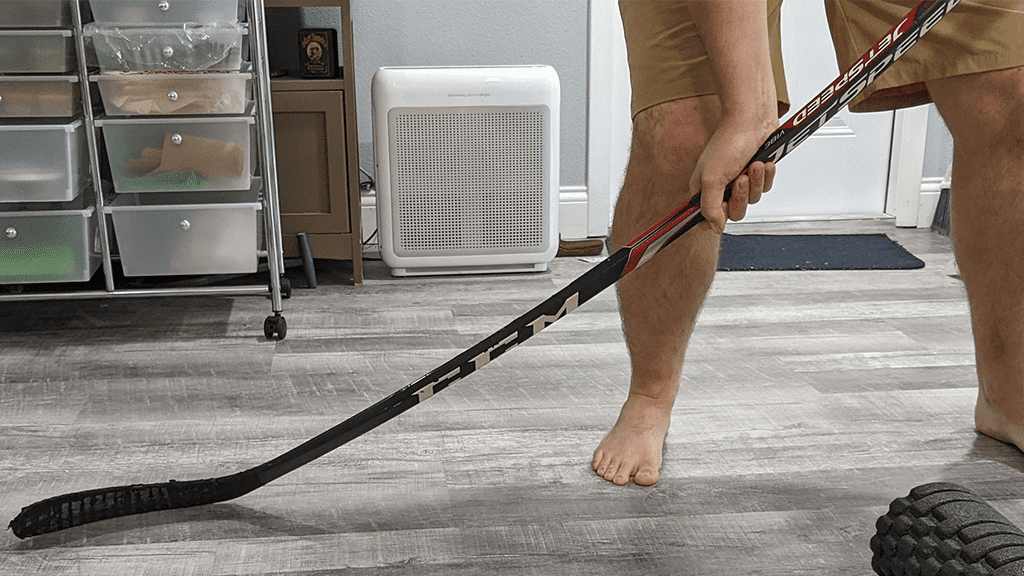
Lean into your stick and see if you hear anything. If your stick is broken when you flex the heck out of it you are going to be able to tell. Your stick will most likely crumble if it is broken at the shaft.
If your stick is broken on the blade the best way to tell is to flip your stick upside down and use your hands to try and bend the blade back and forth. If it is broken you will be able to move the blade around easily.
Can I Repair My Hockey Stick?
According to the hockey stick man, If you have broken the blade of your hockey stick it is most likely not worth repairing. Even the best stick repair people recommend trading in your old stick for a new one if you have broken the blade of your hockey stick.
The blade will never be the same after it has broken, you can get the strength and flexibility back.
But, if it is the shaft of your hockey stick that is broken this is more easily fixed. You can find composite hockey stick repair kits on some sites which allow you to even do this at home if you feel up to the challenge.
Repairing the shaft of your stick involves cutting the shaft where it has been broken and putting a repair sleeve inside of the shaft that has been epoxyed to the inside. The epoxy reminds me a lot of J.B. Weld. The kits also come with an end plug that goes on the handle of your stick to bring your stick back to its original length.
What Hockey Stick Should I Buy If I Need A New One?
This is a question that only you can truly answer but I can tell you the difference between the levels of a hockey stick and from there you can decide which one best fits your style and level of play as well as your budget.
The first question I would ask myself when looking into getting a new hockey stick is, “did I like my last stick?”
If the answer is yes why not stick with that one again?
But if you want to try something new but aren’t sure what the differences are in the million different stick options we will try and help out.
Think of hockey sticks in three different tier levels. Cheap, Moderately priced, Super priced.
Cheap hockey sticks will run you less than $100. These sticks are noticeably heavier than some of the more expensive sticks. This is the biggest downfall to them. However, that extra bit of weight also means that these sticks are much tougher. I still have the first stick I ever bought. I don’t use it really but that thing is built like a tank.
The intermediate-priced sticks will run you between $100-$200. You will notice a big decrease in weight compared to cheaper sticks. You will also notice that these sticks have better performance as well. You will be able to feel the puck more and get off a quicker, more powerful shot. As long you kinda know what you’re doing.
Super-priced sticks are priced between $250 and $400. These hockey sticks are made with materials that have been engineered specifically for playing hockey. These sticks are incredibly light, and very well balanced like an amazing chef’s knife. As I stated above, the high price does not mean your stick will last longer. Actually, these high-end sticks tend to be more fragile than the cheaper model sticks.
Honestly, most beer league players will not notice the benefits of the super-priced sticks when compared to the intermediate-priced sticks. It’s my opinion that most players in adult recreational hockey leagues should get a stick in the intermediate range. You have a large selection to choose from at that price point.
How To Determine How Much Flex I Need
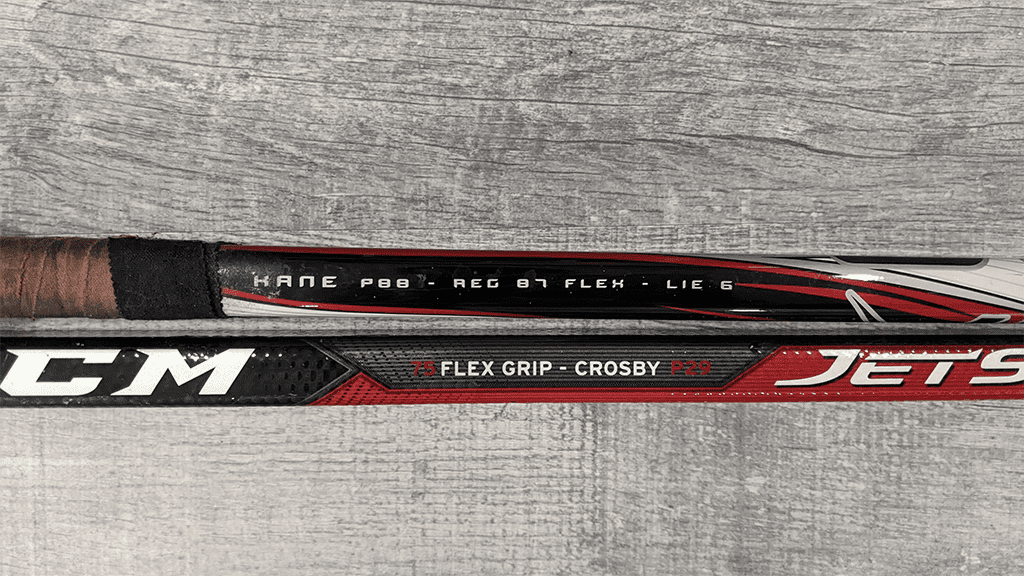
The most common flex rating for adults playing in beer league hockey is an 87 flex rating.
The flex rating on your stick determines how much weight you need to put on your stick in order for it to bend. This is what creates the power that really zips the puck off of your stick. The higher the number, the harder it is to bend the stick.
If you choose a flex that is too low you risk snapping your stick and having a shot that could be stronger. On the other hand, if you choose a stick with a flex that is too high you will not be able to properly load the stick.
The general rule that most people will tell you when picking your stick flex is to take your body weight and cut that in half and that should be your flex. However, I have not found that rule to be true.
According to this, I would need a stick with 100 flex. So, I listened to what others said and bought a 100 flex stick and that thing was so hard to use! I could not get a decent wrist shot off to save my life. I found 100 flex to be way too stiff for me. I prefer an 85-flex stick or even a 75-flex stick over a 100-flex stick.
If you aren’t sure which flex you should get, I suggest going to the pro shop and picking up a few sticks with different flex ratings and trying to flex them a bit by putting the blade on the ground and leaning into the stick a bit.
But, be careful. Don’t break a stick you don’t own.
Picking The Best Curve For A New Hockey Stick
There are lots of blade curves on the market. Each brand has its own name for the blades but many of them are similar to each other.
Generally, blades that are a bit more flat and large are great for defensemen while blades that have a bit more of a curve on the toe are great for shoots and danglers.
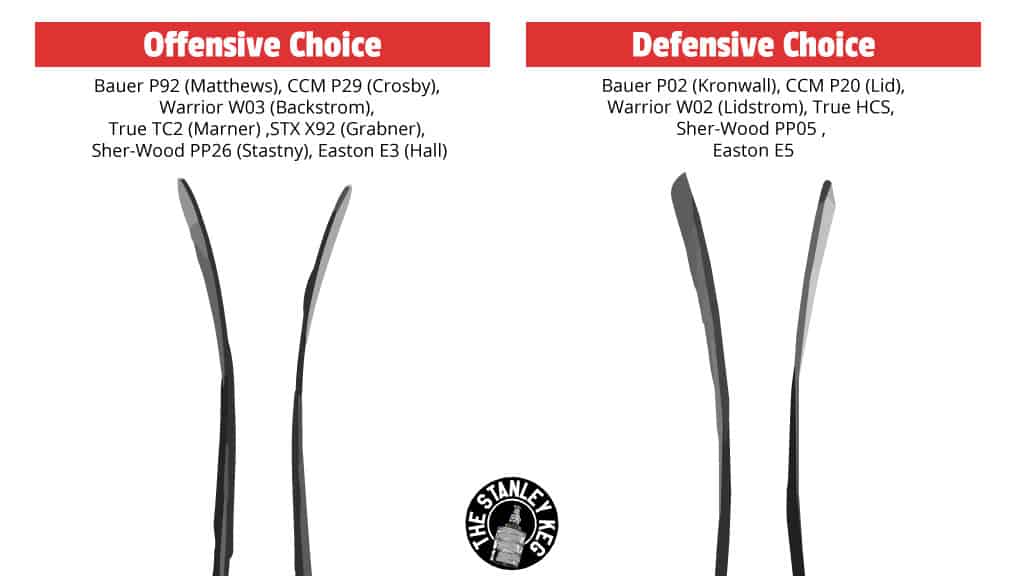
| Common Names W/ Bands | Advantages | Disadvantages |
| Bauer P92 (Mathews)CCM P29 (Crosby)Warrior W03 (Backstrom)True TC2 (Marner)STXX92 (Grabner)Sher-Wood PP26 (Stastny) Easton E3 (Hall) | Snapshots and Wrist Shots. Great Power and accuracy for both. Lifting the puck | Backhand shots and handling Some may think the blade can lift the puck too much. |
| Bauer P88 (Kane) CCM P40 (MacKinnon)CCM P80 (Ovechkin)Warrior W88 (Gaudreau)True MCSTX X88 (van Riemsdyk)Sher-Wood PP88 (Ryan)Easton E36 | Puck control and stick handling. Close to the ice (low) wrist and snapshots. | The blade shape can make it difficult to lift the puck. Backhand shots. |
| Bauer PM9 (Larkin)CCM P14 (Duchene)Warrior W01 (Scheifele)True MC2STX X9Sher-Wood PP96 (Bouchard)Easton E4 (Cammalleri) | Sending and receiving passes. Backhand shots Deflections | Stickhandling Wrist shot power Lifting the puck |
| Bauer P91A (Staal)CCM P6 (Phaneuf)CCM P15 (Jones)Warrior W05 (Granlund)True HCRSTX X91Sher-Wood P20Easton E6 (Drury) | Chipping pucks high Board play Slapshots | Stickhandling Too much lift |
| Bauer P12 (Kessel)CCM P38 (Forsberg)CCM P45 (Tavares)Warrior W16 (Karlsson)Easton E9 | Giving and receiving passes on both forehand and backhand. Board play because of the squared toe. | Shooting Stickhandling |
| Bauer P28 (Eichel)CCM P28 (McDavid)Warrior W28 (Gallagher)True TC4STX X28 (Miller)Sher-Wood PP28 | Great power on wrist and snapshots from the toe. Stick handling, especially toe drags Lifting the puck in tight areas | Difficult to learn to shoot off of the toe of the stick if not used to it. Too much lift of the puck Backhand shots |
| Bauer P02 (Kronwall)CCM P20 (Lid)Warrior W02 (Lidstrom)True HCSSher-Wood PP05Easton E5 | Ideal for DefensemenChipping pucks up and out Giving and receiving passes Slapshots Board play because of the squared toe. | StickhandlingPuck control Wrist shot power and accuracy. |
| Bauer P106 (Richards)CCM P50 (Gagne)Sher-Wood P09 | Well balanced Great for shot power and accuracy Great for saucer passes | Backhand shots |
| Bauer P14 (Toews)CCM P49Warrior W14 (Chara)Sher-Wood PP14 | Stickhandling and Puck feel Lifting the puck | It is a small blade so it is difficult to receive passes, win faceoffs and deflect the puck. |
| Bauer P08 (Crazy Ovi)CCM P77Warrior W11 (Kremlin)True TC3Easton E38 | Stickhandling Shooting (Sniping Top Corners) | Too Much lift on the puck Backhand shots |
Determining If You Need A New Hockey Stick
You need a new hockey stick if your current stick is broken, or you do not like the flex rating or blade profile on your current stick.
If your stick breaks on the shaft, it is repairable however if the blade is broken you will need to buy a brand new hockey stick.
The most common flex is around 87. Be sure to choose a blade profile that fits your play style. There are lots of different shapes on the market.
You might also be interested in
